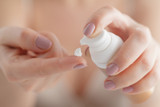
Think the FDA does a questionable job regulating what goes into our food supply? You'd be equally - if not more -shocked by its regulation (or the lack thereof) of cosmetic and personal-care products. The same way you look at food labels for less than desirable ingredients, you really need to analyze the labels on your beauty products too.
Many cosmetic companies use chemicals or ingredients that are actually bad for your skin and health. There are thousands of chemicals in beauty products, many of which absorb directly into your skin (and blood stream).
While it's impractical to list all of the toxic ingredients commonly used, let’s take a look at 3 big offenders you should avoid if you want to keep your beauty routine "green."
Ingredient #3: Parabens
You have probably seen the claim “no parabens” on some of the more natural and organic beauty packaging, but do you know what parabens are even used for in cosmetics? According to the FDA, parabens are synthetic preservatives put in products to prevent the growth of bacteria, mold and fungus. They aren’t always listed specifically as “parabens” in the ingredient listing, so you have to watch out for a litany of words, like butylparaben, ethylparaben, methylparaben, and propylparaben.
Though the safety of parabens and the effect on human health is largely unknown, essentially long-chain parabens may disrupt your endocrine system, which is in control of the hormones in your body. And hormones affect nearly every function of the human body.
According to green beauty expert Jessica Assaf of Beauty Lies Truth:
"To frame this logically: parabens are hormone disruptors that mimic estrogen, and high estrogen levels put us at risk of breast cancer. The longer a woman is exposed to estrogen, the greater her chance of developing breast cancer, which is why early puberty is problematic. A 2011 study by doctors at the California Pacific Medical Center found that when noncancerous breast cells from high-risk patients were exposed to parabens, they started behaving like cancer cells. They were also found to block drugs used to treat estrogen-sensitive cancers. Breast cancers are already the most common form of cancer in the United States, and breast cancers are predicted to rise by 50% by 2030, according to the National Cancer Institute."
Parabens in their various forms rank from 4 all the way up to 8 on Environmental Working Group's Skin Deep scale of ingredient toxicity (0 being least toxic to 10 being the most toxic). It’s just safer at this point to avoid parabens altogether. There are many paraben-free beauty products and even more alternative preservatives that can be used to replace parabens. Essential oils and herbs like rosemary, clove, thyme, cinnamon, tea tree, and lavender can be used synergistically to act as natural, effective bacteria, mold and fungus inhibitors.
Ingredient #2: Synthetic Fragrance
Artificial and synthetic fragrance may have all kinds of troubling effects on your skin and even for your respiratory system. Think allergies, irritation, and breathing problems that some people may be more susceptible to when exposed to synthetic fragrance than others.
Assaf asserts:
"Fragrance: This word on a label could mean between 10 and 300 different chemicals, but companies are not required to list anything in their “fragrance” mixture. Common synthetic fragrances contain hormone disruptors such as phthalates, which have been linked to an increased risk of breast cancer and reproductive problems like early puberty, and the feminization of baby boys."
Even if you don’t overtly have sensitive skin, it’s just better to stick to products, including makeup and skin care, that don’t contain extra added artificial fragrance.
Generally speaking, synthetic fragrance isn't really necessary in most products. For example, the natural fragrance of argan oil has a slightly nutty and appealing scent all on its own. It truly doesn’t need anything added to the pure oil, so what’s displayed on the bottle is exactly what you are going to get.
Ingredient #1: Phthalates
These are a group of chemicals that are in a variety of cosmetic products, including facial oils, lotions, and hairspray. Mineral based cosmetics don't usually have this kind of added chemical, which is definitely a positive attribute to going green with your beauty. Phthalates are also considered an endocrine system disruptor. Make sure your nail polishes don’t have dibutyl phthalate (DBP) in them. This is definitely a category of cosmetic ingredients that the FDA carefully continues to monitor.
According to Vanessa Cunningham, a New York-based nutrition & lifestyle coach:
"It’s impossible to avoid every single synthetic chemical, but you can do your part in limiting the amount of toxins your body is exposed to. Be sure to: eat clean, avoid chemical-laden processed foods, drink plenty of filtered water and look for products that are certified organic if you want to avoid these toxic chemicals. Educate yourself and do your research before you buy."
Green beauty ideally is more natural for your skin than traditional mainstream cosmetics. Responsible “green beauty” lines avoid these big bad three at all costs. You can check out the EWG’s Skin Deep Database to research toxic chemicals that could be in your cosmetic and personal care products.
Once you get used to the terms and how ingredients are listed, it will soon become second nature to look over anything you want to buy before you actually make your purchase. Smart and transparent companies will list each of their product's ingredients right on their websites, so you'll know exactly what you are getting.
Above all being a wise consumer just makes sense. It’s not that hard to look at the ingredient listing of each cosmetic item you buy just to make sure it’s not loaded with harmful stuff.
